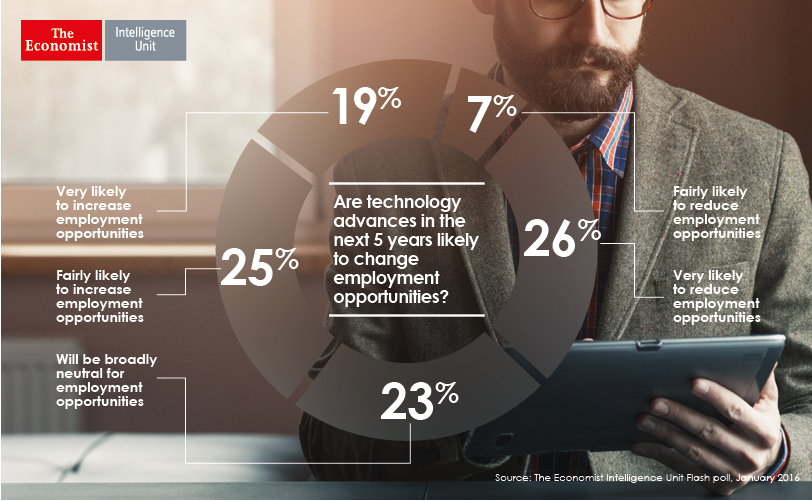More business leaders believe that technology innovation will increase employment opportunities in the next five years than reduce it, according to a new poll by The Economist Intelligence Unit.
However, it is not good news for everyone. Executives in the manufacturing industry, for example, are more pessimistic about employment in the future.
Top of the agenda at this week’s World Economic Forum Annual Meeting at Davos is the so-called “Fourth Industrial Revolution”, which the WEF defines as the “fusion of technologies that is blurring the lines between the physical, digital and biological spheres”. It is, the WEF contends, the latest in a series of consecutive revolutions: first steam and mechanical production; followed by electricity and mass production; and most recently electronics, IT and automation.
Much of the discussion at Davos has focused on the impact of technology on employment. This evergreen debate was most recently reinvigorated by a 2013 paper from the Oxford Martin School. Authors Carl Benedikt Frey and Michael Osborne argued that the growing sophisticated of artificial intelligence and robotics mean that 47% of job roles currently available in the US will be computerised by 2025.
Since then, economists have debated whether this computerisation will lead to widespread unemployment, or whether new employment opportunities created by technology will compensate for the loss.
This week, The Economist Intelligence Unit asked 622 executives from around the world and from a range of industries for their views on the Fourth Industrial Revolution. They are broadly optimistic, it found: 44% of executives believe that technology innovation will lead to increased employment opportunities in the next 5 years, compared to 33% who believe that employment opportunities will be reduced (23% believe it will be neutral).
But this optimism is not universal. Executives in some sectors were mostly positive - 51% of respondents from the professional services sector expect employment opportunities to grow - but, in others, the gloom outweighed the hope. For example, 38% of executives from the manufacturing sector believe employment opportunities will fall, compared to 33% who think they will grow.

It stands to reason that not all industries will be affected in the same way. Employment in manufacturing is especially exposed to technology innovation - this sector is already most likely to use robotics, and this will only increase as costs fall and functionality improves.
However, if the likes of Frey and Osborne are to be believed, the coming wave of automation will affect clerical workers as well as physical labourers. Are executives in more knowledge-based industries underestimating the turmoil ahead?
Speaking to The EIU at Davos this week, Arun Sundararajan, a professor at the NYU Stern business school, argued that technology innovation - and in particular, platforms driving the sharing economy - will change not just the volume of jobs, but also the very definition of employment.
“Work will not be organised in discrete units as jobs that are assigned by companies to individuals,” he explained. “Ownership of assets and other means of production will increasingly be with the person providing the labour or the expertise. You see this with providers on Airbnb and Uber: they're micro-entrepreneurs of sorts.”
As new digital technologies revolutionise not just the act of work itself but also its distribution among workers, it is becoming increasingly difficult to predict labour market trends. Company bosses are broadly positive, the EIU poll reveals. Workers, meanwhile, will have to decide for themselves whether this optimism is well justified.
The views and opinions expressed in this article are those of the authors and do not necessarily reflect the views of The Economist Intelligence Unit Limited (EIU) or any other member of The Economist Group. The Economist Group (including the EIU) cannot accept any responsibility or liability for reliance by any person on this article or any of the information, opinions or conclusions set out in the article.
Further reading:




